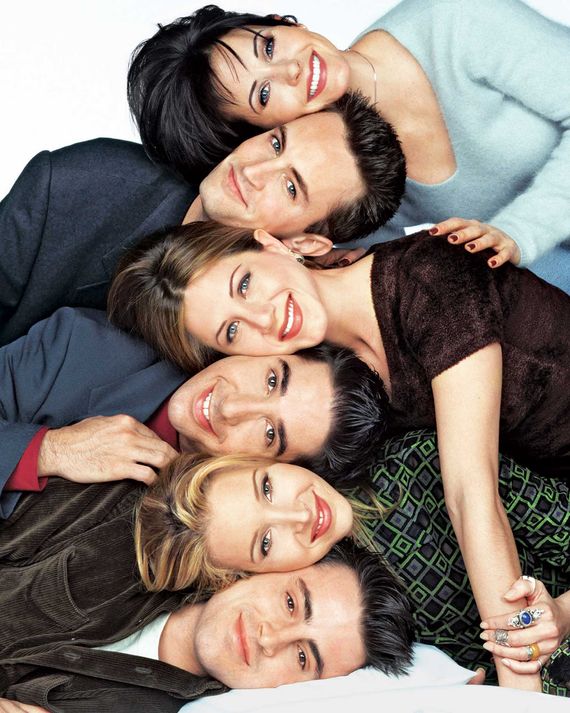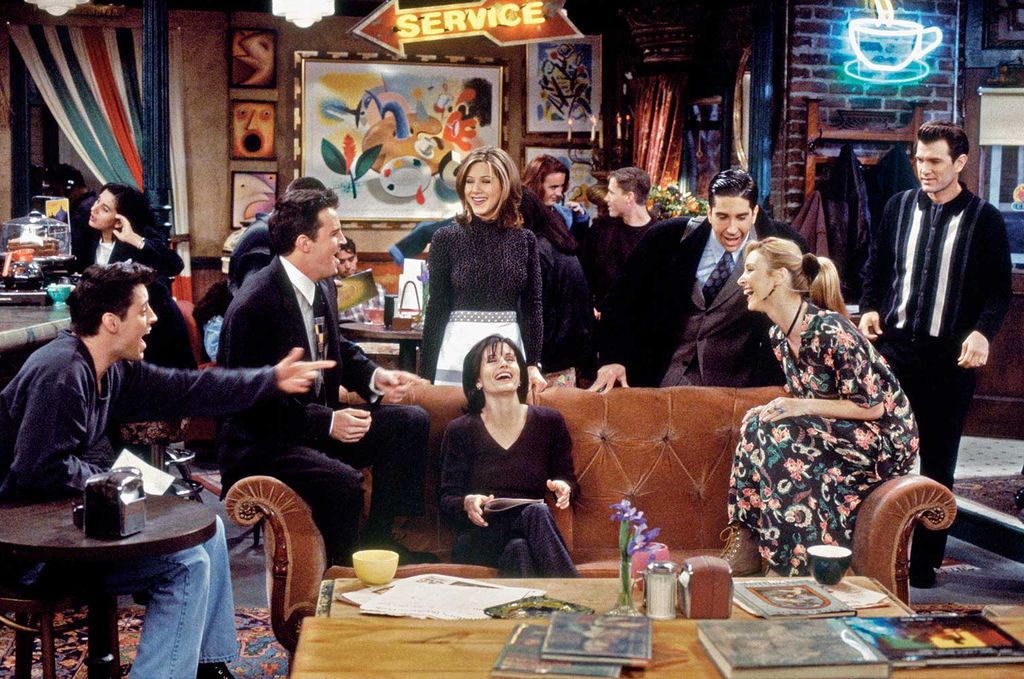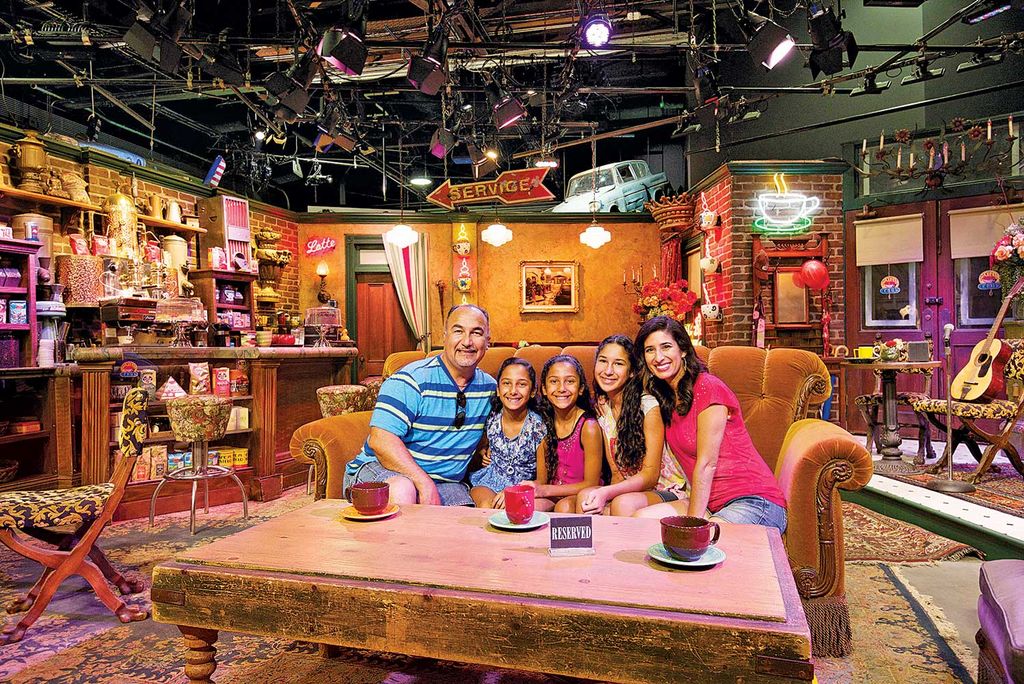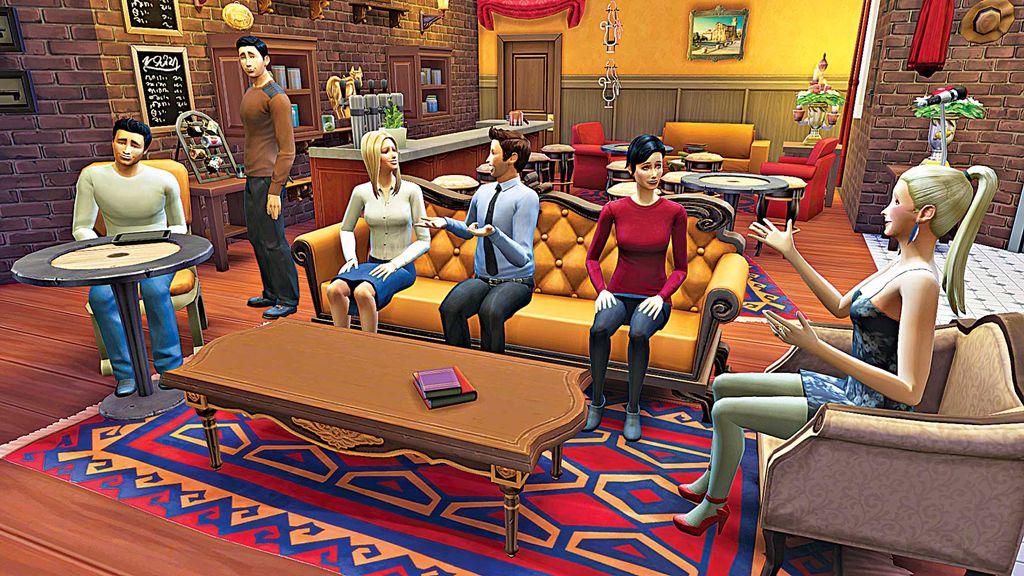
When the TV critic Andy Greenwald, who is 38, returned to his high school near Philadelphia last May to speak to students about his job, he wondered how it would go. After all, today’s students are a digital generation who have only a vague association with the concept of “TV.” Sure enough, when Greenwald mentioned his job to them, one student in the group asked, “So what does that mean? Do you, like, watch Netflix?” Greenwald said, sure, he watches Netflix, since watching original streaming programming — on Netflix, Amazon, Hulu, wherever — is all part of covering the complex new television landscape. Then he asked the teenagers if they watch Netflix. They said, enthusiastically, Yes. So he asked them what they like to watch on Netflix. They said, enthusiastically, Friends.
You remember Friends, right? Chandler, Monica, Joey, Phoebe, Rachel, Ross, and, fleetingly, that monkey? Central Perk? “We were on a break”? The show that feels, in its way, as iconic a relic of the 1990s as do Nirvana, Pulp Fiction, and a two-term Clinton presidency that the Onion later cheekily described as “our long national nightmare of peace and prosperity”?
Friends was not only born of that era but may, in hindsight, embody it more completely than any other TV show. Sexier than Cheers, less acerbic than Seinfeld, Friends existed at the sweet spot of populist mass entertainment and prescient pop escapism. If you were alive and sentient in the 1990s, you already understand this. In fact, if you were in, or near, your 20s back then and ever found yourself seated in a quirkily named coffee shop (e.g., Bean & Gone, Brewed Awakening, CU Latte) with a bunch of your own friends, you might have had the conversation: So, which Friend are you?
But while Friends inarguably excavated the Zeitgeist, it was a very different geist, in a very different Zeit. For starters, the show’s run, from 1994 to 2004, corresponds almost exactly with that transformational decade when people went from signing up for this weird new thing called “email” to signing up for this weird new thing called “Facebook.” The world of Friends is notable, to modern eyes, for what it encompasses about being young and single and carefree in the city but also for what it doesn’t encompass: social media, smartphones, student debt, the sexual politics of Tinder, moving back in with your parents as a matter of course, and a national mood that vacillates between anxiety and defeatism. (Not to mention the absence of any primary characters on the show who aren’t straight or white.) Which is why you might expect that Friends, like similar cultural relics of that era, would be safely preserved in the cryogenic chamber of our collective nostalgia. And yet, astonishingly, the show is arguably as popular as it ever was — and it is popular with a cohort of young people who are only now discovering it. Which is weird. It’s one thing to be young, single, and carefree in the city and drawn to a show that purports to be a reflection of your life, or, at least, some fantasy of how you’d like your life to be. It’s quite another to be drawn to a show that’s a reflection, or a fantasy, of what life used to be like for a bunch of carefree 20-somethings 20 years ago. Because if the allure of the show is, on a basic level, all about wish-fulfillment, well, what exactly is the wish that’s currently being fulfilled?

I’m sitting on the couch. The actual couch. It’s inside the actual Central Perk café set, which is now part of the Warner Bros. studio tour in Burbank, California. The couch — this familiar overstuffed orange sofa — is, for many people, the main attraction on the whole tour. Before our group set off in an elongated golf cart to patrol the studio’s back lots, the guide asked if there were any Warner Bros. shows or movies — for example, The Big Bang Theory, The Dark Knight, or The Matrix — that people were particularly interested in seeing. “Friends!” came the first, quickest answer. “Friends,” came the second. Another woman from the back called out “Friends!” before someone finally said “Harry Potter.” Later, I asked the guide if that was a typical reaction. “I’m not going to lie,” he said. “Friends is definitely the biggest attraction.”
Last year, Danny Kahn, the executive director of the Warner Bros. tour, announced a major expansion titled “Stage 48: Script to Screen,” which includes the stage set for Central Perk. “We’d always had the set on the tour,” he says — though previously it had been stored in a space that was difficult to access. Now the authentic Central Perk sits on its own special replica soundstage, waiting for your visit. In part, the decision to highlight Central Perk was intended to draw international tourists, since the show is such a huge hit globally, but it was also a general response to persistent audience demand. In 2014, to celebrate the 20th anniversary of the show’s debut, Warner Bros. collaborated with a coffee company to set up a pop-up Central Perk in Manhattan. The café had a two-hour wait, with lines around the block, and the main attraction was the chance to sit on a replica couch. (There have also been replica Central Perks in Beijing, Sydney, and Liverpool.)
At Stage 48, it’s not unheard of for people to get engaged on the couch; a guide told me it happened just a few weeks ago. I asked him if any visitors — some of whom have traveled from across the world on a kind of pilgrimage — ever have unusual reactions when they finally sit on the couch. “Oh, yes,” he said. “People cry. All the time.”
It is, of course, slightly strange that a 20-year-old sitcom still retains such a magnetic appeal; for example, Warner Bros. also produced ER, which ran for 15 seasons, but there’s no opportunity, nor likely much demand, to have your photo taken on that show’s authentic gurney, let alone get engaged on it. Yet Friends’ popularity seems to be on the rise. Between its various syndicated airings, the show still draws a weekly audience of 16 million in the U.S., a big enough viewership to make it a viable hit on current network TV (and that’s not even including streaming). In the U.K., ratings for Friends repeats are growing, up more than 10 percent in 2015 from the previous year. And as of January 1, 2015, the entire run of Friends — all 236 episodes, or 88 hours’ worth — has become available on Netflix; the company paid an undisclosed sum for the rights to stream it. (The best industry guess put the price at roughly $118 million.) Netflix, notoriously, doesn’t release information about how many people are watching its shows, but the sitcom appears to be winning a whole new audience. “The social chatter was huge,” says Erin Dwyer, a Netflix spokesperson. “And we’ve been talking to a lot of teen-oriented outlets, like Seventeen and Teen.com, and what we’ve been interested to learn is that they get just as much buzz and clicks for Friends as they do for something like Pretty Little Liars, which is on the air right now.”

Another person who’s noticed a resurgence in Friends-mania is someone with some expertise on the subject: Marta Kauffman, who was a co-creator of the show with David Crane. “It blows my mind,” she says. “Not only that people are still watching but that people still connect to it. I have a 17-year-old daughter, and recently someone at her school asked her, ‘Hey, have you seen this new show called Friends?’ ”
Kayla and Krystie Yandoli are sisters who are currently 23 and 26. In the early aughts, when they were 9 and 12, they cemented their obsession with Friendswhile on a family trip from Connecticut to South Carolina, sitting in the backseat of a minivan equipped with a VCR. “We watched classic episodes like ‘The One With the Prom Video’ and ‘The One Where Ross Got High’ countless times,” Kayla told me. Now Krystie is a staff writer, and Kayla an intern, at BuzzFeed. Both of them write about Friends, a lot. Between them, they’ve written such posts as “23 of Monica Geller’s Most Iconic Lines on ‘Friends’ ” and “How Well Do You Remember the Pets From ‘Friends’ ?” (Spoiler: Probably not that well, unless you remember the name of Rachel’s childhood dog. It is LaPooh.) The fourth-most-popular post Krystie has ever written, with nearly 1.5 million views, is “72 Truths ‘Friends’ Taught You About Life in Your Twenties.” (“1. Your first job won’t be your dream job … 72. Your friends are the family you choose for yourself.”) Krystie sees many such universal truths in the show — as well as something of the DNA of what people are looking for in today’s online culture. “If you write something online, the more general it is, the more people will relate to it and click on it,” she says. “That’s how Friends feels. It’s relatable to so many people. It’s almost like they made a viral show.”
There are, of course, current shows about the modern lives of young urbanites, any of which would presumably be more relatable to young viewers — but, for some, those shows, in all their circa-2016 grittiness, are a little too real. “I watch shows like Girls and it feels like the raw reality of life,” says Kayla. “Friends is like the sitcom version of life.”
Back in 1994, Friends both anticipated and, with its success, accelerated a burgeoning cultural fascination with young adulthood — that precarious moment when postcollegiate urbanites begin their shaky, flirty dalliance with real life (and each other). Now, of course, much of TV — much of pop culture — is fixated on exactly these young-adult relationships, whether on New Girl or Girlsor Broad City. Crane and Kauffman originally pitched Friends to NBC like this: “This show is about six people in their 20s who hang out at this coffee house.” It’s a deceptively simple synopsis, given that the show they delivered became the template for 20 years’ worth of subsequent pop culture. When, in 2015, The Hollywood Reporter asked over 2,800 industry insiders to pick their all-time favorite show, the No. 1 choice was not The Mary Tyler Moore Show (No. 19), The Sopranos (No. 6), or even Seinfeld (No. 5): It was Friends.
Michelle Cerutti, who lives in Florida, has been a Friends superfan since she was a little kid, even though she was only in kindergarten when the show first aired. “I’m 27 years old now,” she wrote to me in an email. “This connection has never changed.” For a long time, she would fall asleep to DVDs of the show. “When I was 14 years old, going on 15, I went through depression, fights with my own friends, a roller coaster of emotions,” she writes. “The ONLY thing that kept me from crying were the six New Yorkers that I grew up getting to know.”

More than once, when asked about the appeal of the show, a 20-something quoted back to me an iconic line that Monica says to Rachel in the pilot: “Welcome to the real world. It sucks. You’re gonna love it.” They explain that they’ve adopted the line as a kind of generational motto. Which the line was intended to be, sort of, except for a different generation. No matter — the notion has an enduring appeal, especially given that, for 20-somethings now, the real world seems suckier than ever. “The ’90s were a great time,” says Chris Mustacchio, who is 24, works in New York, and estimates he’s seen every episode of Friends more than five times. Like more than a few people I talked to, he describes habitually falling asleep to the show. “If you think about it, back then there was little conflict. It was pre-9/11. You could smoke on airplanes, you could smoke in restaurants. Bill Clinton was in the White House. He was the best president of all time!”
“Post-9/11, the show became more popular,” says Kauffman. “And I think part of the reason is because it was optimistic. And certainly, with what’s going on politically right now, this can feel like a darker time.”
Krystie Yandoli, who is now living in New York, is ostensibly getting the chance to live out all her childhood Friends fantasies. “Obviously, I don’t live in this huge beautiful West Village apartment and sit in a coffee house all day. I’m a real person who needs to pay bills,” she says. Life is a lot less frictionless than it appeared on the show, and yet she still looks to Friends for lessons. “The thing the show did the most for me is shape these ideas about friendship.” Her sister agrees: “You can’t really replicate the initial magic of that very first thing that really gets this connection right,” says Kayla. “So much has changed, but that simple idea of friendship — that’s enough.”
I lived through Friends, once. I was 23 years old when the show premiered, and I watched the Friends pilot under protest, prodded by my little sister. To my slacker-hardened sensibility, the show looked to be, at first glance, an anodyne attempt to chase “the youth” and cash in on the sour magic of Seinfeld. But I watched. And I laughed. And I kept watching. And eventually I had the conversation. (I was Chandler.)
Now I’m in my 40s and there is very little about the current world — especially culturally speaking — that reminds me of the world of Friends. When I was in college, people were still brandishing dog-eared copies of Neil Postman’s anti-TV polemic Amusing Ourselves to Death; now TV has shrugged off its consensus reputation as a purveyor of widespread idiocy to become the most celebrated artistic form of our time. I currently have a palm-size computer in my pocket that’s smarter than Deep Blue, the supercomputer that beat Garry Kasparov at chess in 1997 — and on which, it turns out, I can stream Friends in its entirety. In 2016, we tweet. We text. We Vine. We swipe right. Friends, of course, reflects none of this. (Mentions of the internet are limited to very occasional high jinks, like Chandler meeting a woman online who turned out to be his ex-girlfriend Janice.)
I am, however, surprised that a whole new generation — all of whom are presumably much more tweet-, text-, Vine-, and Tinder-friendly than I am — is feeling the same way, and expressing it by embracing the very show my generation once embraced. After all, each generation has the right to bury the icons of its forebears, just as we in our Screaming Trees T-shirts once shat all over the Eagles. Instead, these kids are going to Friends trivia nights at Asian-fusion tapas bars in midtown, and starting podcasts devoted to recapping and analyzing every single episode of the show.
“Part of the appeal is wish-fulfillment,” says Kauffman of the show’s continued appeal to younger viewers. “And another part of it is because they’re on social media all the time, so I believe they crave human contact. They crave intimacy, and intimate relationships. They’re looking at screens all the time.” The world of Friends is recognizable, yet devoid of today’s most ardent anxieties. On Friends, “in their free time, they all get together in the coffee shop to chat and catch up,” says Stephanie Piko, a 21-year-old fan of the show. “Where nowadays we’ll catch up really quickly, but everyone’s always on their phones. Back then, it’s more of a person-to-person relationship, instead of through technology.” In hindsight, that era seems idyllic by comparison: a fantasy life where friends gather on a sofa, not on WhatsApp.

In the economically moribund, malaise-infected ’70s, there was a similar upsurge in nostalgia for the ’50s, as manifested in movies like Grease and shows like Happy Days. Yet now, thanks to the internet, we don’t need to re-create the euphoric, prelapsarian feeling of an old show like Friends — we can just as easily stream Friends itself. In doing so, we can plug into the fantasy of a time not that long ago but in a completely different age, one that feels both familiar and contemporary in its mores and hairstyles (you can still plausibly get away with a “Rachel”) yet fantastically more appealing in its promise of human connection, back when “connection” had an entirely different meaning.
I asked Elizabeth Entenman, a 27-year-old Friends fanatic, if you could make a version of Friendsabout the 20-somethings of today. “No,” she said, “because you wouldn’t find six people doing nothing in the same room.” Or if they were, they’d all be on their phones, seeing what else is out there. On modern sitcoms like Netflix’s Master of None or Love, the agony of the slowly answered, or never-answered, text is a recurring plot device, so familiar and realistic that it makes us squirm as much as the character does onscreen. There’s no escapism to be had there. Instead, it reminds us of the sad modern paradox: that knowing you can reach out to anyone at anytime hasn’t actually brought us any closer together.
And so the central pleasure of watching Friends — the feeling of being cosseted in a familiar place, free of worries, surrounded by friends — has never been quite so longed-for as it is now. Paulina McGowan, who is 21, was born in 1994, the year Friends debuted. Watching it now, she says, “It would be awesome to be alive back then, when everything didn’t seem so intense. It just seemed really fun.” After the WB tour, having hoisted myself up from that magical couch, I found it impossible while driving around L.A. to escape — or ignore — the pop hit “Stressed Out,” by Twenty One Pilots (current YouTube views: 152 million and counting). The song features the telling refrain: “Wish we could turn back time, to the good ol’ days / When our momma sang us to sleep / But now we’re stressed out.” Eventually, we all grow up and move out of range of our mommas’ voices. But I couldn’t help but think of all those young people who told me they now like to fall asleep to Friends.
*This article was originally published in the March 21, 2016 issue of New York Magazine.